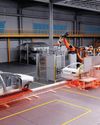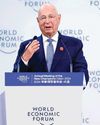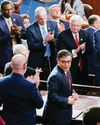
THE SOUNDTRACK SUGGESTED A BEYONCÉ CONcert. The light-up bracelets evoked the Eras Tour. And the exuberant crowd-more than 14,000 strong, lining up in the rain-resembled the early days of Barack Obama. Inside a Philadelphia arena on Aug. 6, Vice President Kamala Harris was greeted with a kind of reception a Democratic presidential candidate hasn't gotten in years. Fans packed into overflow spaces, waving homemade signs made of glitter and glue as drumlines roared. When Harris introduced her new running mate, Minnesota Governor Tim Walz, the cheering lasted more than a minute.
If you'd predicted this scene a month ago to anyone following the race, they would never have believed you. But Harris has pulled off the swiftest vibe shift in modern political history. A contest that revolved around the cognitive decline of a geriatric President has been transformed: Joe Biden is out, Harris is in, and a second Donald Trump presidency no longer seems inevitable. Democrats resigned to a "grim death march" toward certain defeat, as one national organizer put it, felt their gloom replaced by a jolt of hope. Harris smashed fundraising records, raking in $310 million in July. She packed stadiums and dominated TikTok, offering a fresh message focused on the future over the past. Volunteers signed up in droves. Trump's widening leads across the battleground states evaporated.
Over the span of a few weeks in late July and early August, Harris became a political phenomenon. "Our campaign is not just a fight against Donald Trump," she told the cheering crowd in Philadelphia. "Our campaign is a fight for the future."
This story is from the {{IssueName}} edition of {{MagazineName}}.
Start your 7-day Magzter GOLD free trial to access thousands of curated premium stories, and 9,000+ magazines and newspapers.
Already a subscriber ? Sign In
This story is from the {{IssueName}} edition of {{MagazineName}}.
Start your 7-day Magzter GOLD free trial to access thousands of curated premium stories, and 9,000+ magazines and newspapers.
Already a subscriber? Sign In

Q & A: Borge Brende
The World Economic Forum president talks with TIME editor Sam Jacobs

Q & A - Rene Haas
Arm's CEO on how his hardware is supporting the Fourth Industrial Revolution

The conflicts looming over 2025
WHEN DONALD TRUMP TOOK THE OATH OF OFFICE AS President in January 2017, his first foreign policy priority was to get tough on China. The Trump 2.0 Administration will continue that work. But when he strides back into the Oval Office in January 2025, Trump will also become responsible for U.S. management of two dangerous wars, the kinds of hot foreign policy crises he was fortunate to avoid during his first term.

Rev Lebaredian
Nvidia's vice president of Omniverse and simulation technology on training AI-powered robots

5 predictions for AI in 2025
New uses and policy questions come into focus

Roy Wood Jr. The comedian on his new stand-up special, the importance of working in food service, and learning from Keanu Reeves
8 QUESTIONS WITH Roy Wood Jr.

A call for global cooperation in the Intelligent Age
Cultivate wisdom along with innovation

The D.C. Brief
IN THE END, THE THREAT OF A FARright revolt proved more menacing than most imagined, as Republican Mike Johnson initially came up short on Jan. 3 during the first balloting to keep him as Speaker.

The digital labor revolution
OVER THE PAST TWO YEARS, WE'VE WITNESSED advances in AI that have captured our imaginations with unprecedented capabilities in language and ingenuity. And yet, as impressive as these developments have been, they're only the opening act. We are now entering a new era of autonomous AI agents that take action on their own and augment the work of humans. This isn't just an evolution of technology. It's a revolution that will fundamentally redefine how humans work, live, and connect with one another from this point forward.

Tech we can trust
Serving humanity's best interests must be at the center of progress